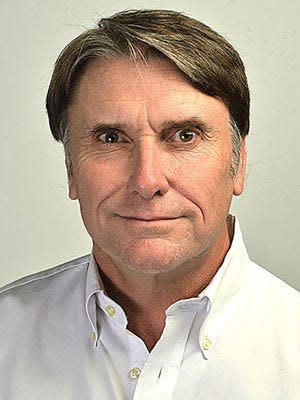Trump, Bankman-Fried seem to be two sides of the transactional coin
- Oops!Something went wrong.Please try again later.
The trials of two peculiar men began this week, men so polarly opposite yet so exacting in their sameness that any attempt to connect or separate their psyches is bound to be an exercise in futility.
But futility and newspaper columns are kissing cousins, so it becomes an exercise too compelling to ignore.
Both Donald Trump’s empire of real estate and Sam Bankman-Fried’s empire of crypto were to one degree or another houses of cards, puffed up by exaggerations of grandiosity or an asset class whose value is impossible to know.

Their politics were opposite, yet their attributes and flaws were startingly alike. And these mirror-image story arcs, according to author Michael Lewis, came within a whisper of intersecting in a nuclear, history-altering way.
The pop psychological analysis of both, for what it’s worth, is well accepted. Trump was the product of a ruthless father for whom the slightest sign of weakness was the greatest of all failings. Bankman-Fried was a classic product of the STEM generation who believed everything could be explained by math. Both these philosophies — one based entirely on emotion, the other entirely on the lack of it — seemed to snuff out the basic elements of humanity that go by the name of a moral compass.
To Trump, human relations were founded on loyalty. In most cases the loyalty was one-way, but it at least was based on a fundamental understanding of the human condition. Of Trump’s talents, his greatest and most paradoxical is his ability to engender the sincerity in others that he himself lacks.
Bankman-Fried seemed not to even understand the concepts of loyalty or sincerity. Lewis writes that human relationships to Bankman-Fried were mathematical equations. He would agree to meet with most anyone, but at the appointed time he would calculate whether this interaction would for him be a net gain or loss, and either show or not show accordingly.
The end results, of course, were the same. People were viewed as commodities, a flesh and blood bushel of soybeans that was either needed or not needed at any particular point in time. The feelings, hopes and dreams of these soybeans were never considered.
Trump was the front man, the deal-maker who was always hustling his own particular brand of snake oil. From the New York City Council to Saudi Arabia he was always pitching, always keenly aware of who might be in a position to give his brand a boost and even more keenly aware of who might stand in his way.
Bankman-Fried never asked people for their money, but many people lined up to ask for his. The world’s most rich and powerful showed up on his Zoom screen, hawking some company, some politician or some philanthropic event. Lewis writes that Bankman-Fried somewhat vacantly agreed to anything that was asked of him, but what the earnest people on the other end of the call didn’t know was that their quarry had almost immediately switched screens and instead of watching them was intently playing a video game — throwing in an occasional “yup” or “interesting” as his part of a conversation he was entirely divested of.
Business owners who believed Bankman-Fried had agreed to buy their company flew to the Bahamas to consummate the deal only to discover that the boy wonder had no recollection of ever talking to them.
Trump was always selling. Bankman-Fried was always buying. Neither was known for delivering.
And of course there was money beyond compare. But when Forbes came calling, Trump feared the reporters would settle on a net worth that was too low. Bankman-Fried worried that the magazine would report a figure for him that was inconveniently high.
At this critical point in history, Bankman-Fried was worth $40 billion, which dwarfed Trump’s puny $3.2 billion. The kid thought the old man was a threat to American democracy, and the old man knew the kid had the kind of money he craved; the paths of the calculation-making Bankman-Fried and the deal-making Trump were about to cross.
A back channel between the camps was reportedly established, and Bankman-Fried’s people asked Trump his price for not running for president. They got their answer: $5 billion.
Events, of course, intervened before any such historically epic deal could be finalized. And maybe this was a serious proposal, maybe it was just another ephemeral ripple in both men’s prodigious fantasy worlds.
But it highlights two worlds divorced from reality, two worlds untouched by the leavening agents of arts, humanities, good manners and good faith, where worth is measured in gilded toilet seats and video game prowess.
It is unfortunate that American education has been eliminating the cultural coursework that might have introduced beauty and philosophy to these constrained and twisted worlds. Because it means, going forward, we will be treated to more of the same.
More: Trump's Victory in Chaos model is one House Republicans are trying to emulate
Tim Rowland is a Herald-Mail columnist.
This article originally appeared on The Herald-Mail: Michael Lewis book highlights Trump, Bankman-Fried connection
